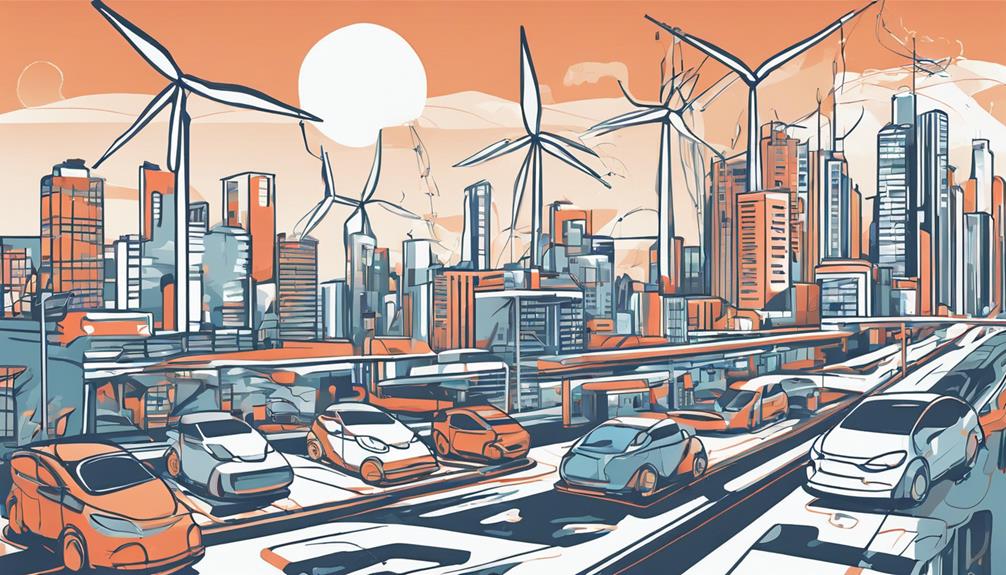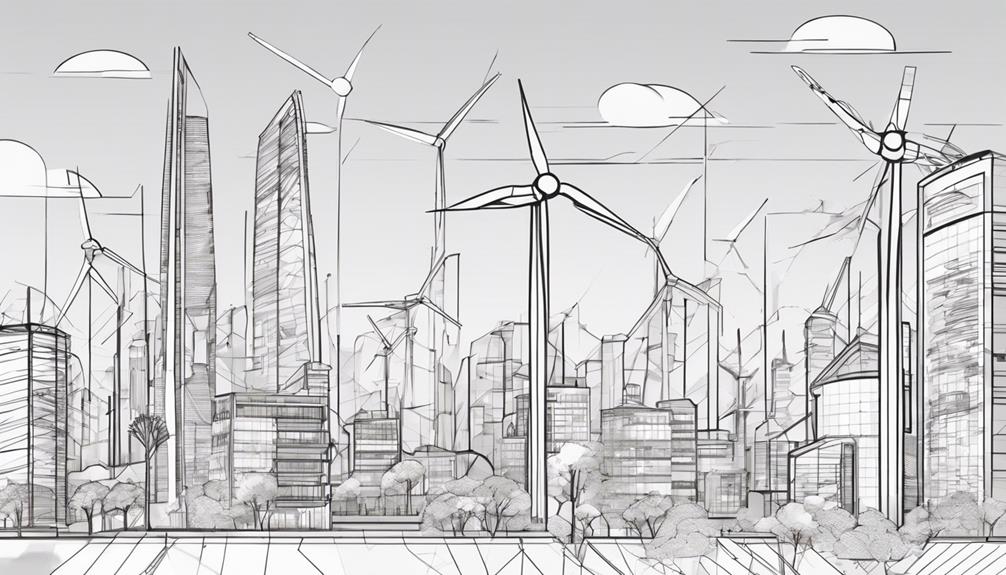Transitioning towards a sustainable future necessitates a multifaceted approach to combat climate change. From reducing our reliance on fossil fuels to embracing renewable energy sources, the solutions are complex yet imperative. But what about the societal shifts needed, the policy changes required, and the technological advancements crucial for this transition? There lies a critical question: how can we effectively implement these strategies on a global scale to achieve tangible results in the battle against climate change?
Key Takeaways
- Transition to renewable energy sources like solar and wind power.
- Enhance energy efficiency through LED bulbs and energy-saving practices.
- Utilize alternative energy sources such as geothermal and hydroelectric power.
- Promote sustainable practices in transportation, buildings, and agriculture.
Ending Fossil Fuel Dependence

Transitioning away from fossil fuels is imperative to combatting climate change and reducing the primary driver of global warming. The combustion of fossil fuels releases carbon dioxide and other greenhouse gases into the atmosphere, leading to a substantial increase in carbon emissions. This upsurge in greenhouse gases contributes significantly to the climate crisis we face today. To address this pressing issue, a transition towards renewable energy sources such as solar, wind, and hydropower is crucial. By investing in renewable energy technologies, we can effectively reduce our reliance on fossil fuels for energy production, thereby curbing carbon emissions and mitigating the impacts of climate change.
Furthermore, phasing out subsidies that support the fossil fuel industry can play a pivotal role in accelerating this transition. Redirecting these funds towards clean energy solutions will not only aid in reducing carbon-intensive fuel consumption but also foster the growth of a sustainable energy sector. Embracing electric vehicles powered by renewable energy is another pivotal step towards reducing emissions, particularly in the transportation sector. By transitioning away from fossil fuels and embracing renewable energy alternatives, we can make significant strides in combatting climate change and securing a sustainable future for generations to come.
Enhancing Energy Efficiency
To effectively address the environmental impacts of energy consumption and further combat climate change, a focus on enhancing energy efficiency is paramount. Energy efficiency measures play a crucial role in reducing emissions, particularly in the realm of heating and cooling systems. By implementing energy-efficient practices, such as weatherproofing buildings and transitioning to LED light bulbs, it is possible to significantly decrease energy use. For instance, switching to LED light bulbs can save up to 80% more energy compared to traditional incandescent bulbs. Moreover, weatherproofing structures can lead to a 20-30% reduction in energy consumption, resulting in lower utility bills and a reduced carbon footprint. Improving home energy efficiency not only benefits the environment but also translates into tangible savings for households, with potential annual energy cost savings ranging from $200 to $400. Transitioning to energy-efficient appliances further enhances these benefits, saving up to $600 annually on utility bills while concurrently curbing greenhouse gas emissions.
Embracing Solar Power

Solar power has become a crucial player in the shift towards renewable energy sources. The efficiency of solar panels, advancements in storage battery technology, and the implementation of government incentives and policies are key points driving the widespread adoption of solar energy systems. Understanding these factors is essential for maximizing the benefits of solar power and accelerating the transition to a more sustainable energy landscape.
Solar Panels Efficiency
The advancement of solar panels' efficiency is a pivotal factor in the widespread adoption and effective utilization of solar power technology. Currently, solar panels have an efficiency rate ranging from 15-22%, with some cutting-edge models achieving up to 40% efficiency. Factors such as sunlight intensity, installation angle, and shading can influence panel efficiency. Technological enhancements like PERC cells and bifacial panels have significantly improved efficiency and overall performance. Maximizing energy production and reducing system costs over the panel's lifespan heavily rely on solar panel efficiency. Ongoing research and development endeavors are dedicated to further enhancing solar panel efficiency to bolster competitiveness and encourage broader integration of solar power as a sustainable energy source.
Storage Battery Technology
Efficiency in solar panel technology directly correlates with the effectiveness of storage battery systems in embracing solar power for sustainable energy solutions. Energy storage plays a crucial role in enabling the utilization of solar power beyond daylight hours. Lithium-ion batteries, known for their high energy density and reliability, are widely utilized in solar energy storage systems. This integration not only promotes energy independence but also enhances resilience against power disruptions. Furthermore, advancements such as solid-state batteries are improving the efficiency and durability of solar energy storage solutions. By incorporating smart technologies, these storage battery systems can intelligently manage energy usage, leading to optimized performance and reduced overall energy costs for users harnessing solar power.
Government Incentives and Policies
Amidst the ongoing global shift towards sustainable energy sources, government incentives and policies play a pivotal role in fostering the widespread adoption of solar power technologies. In the realm of climate and energy, these policies have been instrumental in driving a significant increase in solar power adoption. For instance, the Solar Investment Tax Credit (ITC) offers a 26% tax credit for residential and commercial solar systems, thus incentivizing the development of solar energy projects. Additionally, policies such as Renewable Portfolio Standards (RPS) at the state level mandate a certain percentage of electricity to be sourced from renewables, thereby promoting solar power generation. Net Metering policies further enhance the attractiveness of solar installations by allowing owners to receive credits for excess electricity fed back into the grid. These government initiatives not only create jobs and economic opportunities but also contribute to mitigating climate change by reducing greenhouse gas emissions and diminishing reliance on fossil fuels.
Harnessing Wind Energy

Harnessing the abundant power of wind, researchers have made significant strides in developing efficient technologies for wind energy generation. Wind energy, a renewable source, plays a crucial role in producing electricity while combating climate change. The global wind energy capacity exceeded 743 gigawatts in 2020, indicating substantial growth in the sector. By utilizing wind turbines, the kinetic energy of the wind is converted into mechanical power, subsequently generating electricity. Offshore wind farms present a promising avenue for energy production as they benefit from stronger and more consistent winds at sea.
Compared to fossil fuels, wind energy offers a clean and sustainable alternative, significantly reducing carbon emissions. Its environmentally friendly nature aligns with the global efforts to transition towards greener energy sources. Embracing wind energy not only contributes to a cleaner environment but also helps in meeting the increasing demand for electricity worldwide. Continued advancements in wind energy technology are essential for further expanding its capacity and maximizing its potential in the fight against climate change.
Utilizing Geothermal and Hydroelectric Power
Utilizing the Earth's natural heat and the energy from flowing water, geothermal and hydroelectric power represent integral components of the renewable energy sector, offering reliable and sustainable alternatives to traditional fossil fuel-based electricity generation. Geothermal power taps into the heat stored within the Earth to produce electricity continuously, serving as a dependable renewable energy source. This method boasts minimal greenhouse gas emissions, positioning it as a clean substitute for fossil fuels in the realm of power generation. On the other hand, hydroelectric power harnesses the kinetic energy of flowing water to generate electricity, playing a significant role in global renewable energy production. Hydroelectric dams provide the added benefit of water storage for future use, ensuring a flexible and efficient means of balancing energy demand and supply. Both geothermal and hydroelectric power play a crucial role in reducing carbon emissions and combating climate change by offering sustainable energy options that align with the transition towards a greener energy landscape.
Exploring Biomass Energy

The exploration of biomass energy as a sustainable alternative for heat and electricity production is crucial in the ongoing efforts to mitigate greenhouse gas emissions and transition towards a greener energy landscape. Biomass energy involves utilizing organic materials such as wood, crops, and waste to generate power, making it a renewable energy source as these materials can be replenished sustainably. Here are three key points to consider regarding biomass energy:
- Biomass energy plays a significant role in reducing carbon emissions by displacing the need for fossil fuels in energy production.
- Despite its environmental benefits, challenges exist, including emissions released during the burning of biomass and potential competition with food production for resources.
- Sustainable management practices are essential for biomass energy production to ensure positive environmental impacts and minimize any adverse effects on ecosystems.
Careful consideration and management of biomass energy are crucial to harnessing its potential as a renewable energy source while maximizing its environmental benefits.
Promoting Sustainable Transportation
Promoting sustainable transportation through public transit benefits and bike-friendly infrastructure is crucial in mitigating climate change. By encouraging the use of these modes of transportation, we can significantly reduce carbon emissions and improve air quality. Investing in green travel options not only benefits the environment but also enhances the overall well-being of communities.
Public Transit Benefits
Enhancing the utilization of public transit systems presents a crucial opportunity for advancing sustainable transportation practices. Public transit plays a significant role in reducing carbon emissions, improving air quality, and fostering sustainable urban development. Here are three key benefits:
- Public transit reduces greenhouse gas emissions by an average of 37 million metric tons annually in the U.S.
- Using public transportation can save individuals over $10,000 per year compared to owning a car.
- Accessible public transit can improve air quality by reducing harmful emissions and promoting sustainable urban development.
Bike-Friendly Infrastructure
Amid the imperative shift towards sustainable transportation practices, the development of bike-friendly infrastructure stands as a pivotal solution for enhancing urban mobility and reducing carbon emissions. By investing in dedicated bike lanes, bike-sharing programs, and secure parking facilities, cities can reduce traffic congestion, improve air quality, and promote public health through increased cycling. The implementation of such infrastructure not only benefits the environment but also boosts local economies by attracting tourism, enhancing retail sales, and increasing property values. Moreover, well-designed bike paths contribute to safer streets for all road users, reducing the risk of accidents and injuries. Embracing bike-friendly infrastructure aligns with climate action goals by reducing greenhouse gas emissions from cars and promoting sustainable transportation alternatives.
| Benefits | Description |
|---|---|
| Reduced Traffic Congestion | Dedicated bike lanes help separate cyclists from vehicular traffic, easing congestion on roads and promoting smoother traffic flow. |
| Improved Air Quality | Increased cycling leads to fewer cars on the road, resulting in reduced emissions and improved air quality, which is beneficial for public health and the environment. |
| Enhanced Public Health | Encouraging cycling through bike-friendly infrastructure promotes physical activity, leading to improved public health outcomes and a reduction in sedentary lifestyles. |
| Boost to Local Economies | Investments in bike infrastructure can stimulate local economies by attracting tourists, boosting retail sales, and increasing property values in bike-friendly areas. |
| Safer Streets for All Users | Well-designed bike lanes and paths contribute to safer streets by providing designated spaces for cyclists, pedestrians, and motorists, reducing the risk of accidents. |
Advancing Sustainable Buildings

Sustainable buildings play a crucial role in mitigating climate change through their significant potential to reduce energy consumption and carbon emissions. Incorporating energy-efficient features such as solar panels and green roofs can lead to a substantial decrease in the carbon footprint of buildings. Green building certifications like LEED (Leadership in Energy and Environmental Design) ensure that sustainable practices are followed, resulting in reduced environmental impact and enhanced efficiency. Additionally, the use of sustainable building materials such as recycled steel and bamboo promotes eco-friendly construction methods, further contributing to the overall sustainability of buildings. Furthermore, the integration of smart technologies in sustainable buildings allows for the optimization of energy use and the monitoring of environmental performance, ultimately enhancing the overall efficiency and effectiveness of these structures. By embracing sustainable buildings with energy-efficient features, green certifications, and smart technologies, we can make significant strides towards combating climate change.
Implementing Forestry and Agriculture Solutions
Implementing effective forestry and agriculture solutions is imperative for mitigating climate change through carbon sequestration and emission reduction strategies. Forest management and sustainable agriculture have the capacity to store significant amounts of carbon, with forests currently absorbing approximately 2.6 billion metric tons of CO2 annually. Protecting intact ecosystems and endorsing responsible forestry policies are essential to combat deforestation, a significant contributor to greenhouse gas emissions. Sustainable agriculture practices, including sustainable farming techniques and minimizing emissions from livestock, are crucial industrial solutions for lowering greenhouse gas emissions. It is vital to address the negative impacts of biomass energy, as improper forestry practices for bioenergy can inadvertently release more carbon than they save. By prioritizing conservation-based approaches, such as safeguarding coastal areas and intact ecosystems, biodiversity can be preserved, and the adverse effects of climate change can be mitigated effectively. Responsible forestry policies and sustainable agricultural practices are key components in the global effort to combat climate change.
Practicing Conservation Methods

Forests and agricultural lands play a critical role in climate change mitigation, and one of the key strategies to bolster these efforts is through the practice of conservation methods. Conservation methods such as protecting intact ecosystems and coastal areas can help preserve biodiversity and natural carbon stores. Proper waste disposal and clean-up efforts are essential conservation practices to prevent pollution and safeguard the environment from harmful waste materials. Additionally, planting native species and supporting biodiversity through conservation efforts can enhance ecosystem resilience and contribute to carbon sequestration.
- Protecting intact ecosystems and coastal areas
- Proper waste disposal and clean-up efforts
- Planting native species and supporting biodiversity
Conservation practices not only help in combating climate change but also play a crucial role in maintaining environmental balance. By choosing environmentally responsible products and advocating for bold environmental changes, individuals can actively contribute to reducing the environmental impact and promoting sustainable practices for a healthier planet.
Adopting Industrial Innovations
The adoption of industrial innovations, particularly in the realm of carbon capture and storage technologies, is paramount for reducing greenhouse gas emissions from heavy industries. Carbon capture technologies can effectively trap carbon dioxide emissions produced during industrial processes, preventing them from entering the atmosphere and contributing to global warming. Additionally, enhancing energy efficiency within industrial operations can lead to significant reductions in overall energy consumption and subsequent greenhouse gas emissions. Transitioning towards renewable energy sources, such as solar or wind power, in industrial activities also plays a crucial role in decreasing carbon footprints and environmental impacts.
To facilitate these changes, it is essential to invest in research and development for clean energy technologies specific to industrial sectors. Furthermore, supporting policies that incentivize and mandate the adoption of eco-friendly industrial practices and technologies are vital steps in mitigating the effects of climate change. By embracing these industrial innovations and implementing sustainable practices, heavy industries can make substantial contributions to combating climate change and creating a more sustainable future.
Leveraging Technological Advancements

Technological advancements in innovative green energy, carbon capture technology, and sustainable transportation solutions are pivotal for addressing climate change. Enhanced research and development in these areas can lead to more effective reduction of carbon emissions and environmental impacts. Governments and industries must collaborate to invest in sustainable technologies that promote long-term climate action and a transition to cleaner energy sources.
Innovative Green Energy
Rapidly evolving green energy innovations, driven by technological advancements, are revolutionizing the efficiency and capacity of renewable energy sources worldwide. These advancements are crucial in combating climate change and transitioning to a sustainable energy future.
- Advanced solar panels can increase energy efficiency by up to 22% compared to traditional panels.
- Technological advancements in wind turbines have led to a 50% increase in energy generation capacity over the past decade.
- Hydrogen-based solutions are gaining traction, with the potential to reduce carbon emissions by up to 90% in certain industries.
These innovations not only enhance energy efficiency but also contribute significantly to reducing carbon emissions. With substantial investments pouring into clean energy technologies, the momentum towards a greener future is promising.
Carbon Capture Technology
Leveraging advancements in carbon capture technology is essential for effectively reducing CO2 emissions and combating climate change. This innovative approach targets the removal of CO2 emissions from industrial processes and power plants. By capturing CO2 before it enters the atmosphere, this technology offers the opportunity to either store it underground or repurpose it for other beneficial uses. Direct air capture, a method that extracts CO2 from ambient air, provides a solution to address emissions from various sources. Carbon capture and storage (CCS) processes have shown the potential to significantly decrease CO2 emissions by up to 90% from large industrial facilities. The implementation of carbon capture technology is crucial in reaching net-zero emissions targets and mitigating the adverse effects of climate change.
Sustainable Transportation Solutions
The integration of sustainable transportation solutions is paramount in reducing global carbon emissions and tackling the pressing issue of climate change. Transitioning to electric vehicles plays a key role in lowering greenhouse gas emissions associated with transportation. Technological advancements, such as enhanced battery storage and charging infrastructure, are making electric vehicles more accessible and efficient, further promoting their adoption. Additionally, sustainable fuels like biofuels and hydrogen offer promising alternatives to traditional gasoline and diesel, contributing to the advancement of sustainable transportation solutions. Embracing sustainable transportation options such as walking, biking, and public transit can also help decrease reliance on fossil fuels and reduce carbon footprints.
- Electric vehicles significantly reduce greenhouse gas emissions.
- Technological advancements enhance the accessibility and efficiency of electric vehicles.
- Sustainable fuels like biofuels and hydrogen provide promising alternatives for transportation.
Making Informed Choices

Making informed choices is pivotal in addressing climate change effectively, requiring a deep understanding of the carbon footprint associated with daily activities. By considering the environmental impact of products and services, individuals can make sustainable purchasing decisions. Moreover, being mindful of the energy sources powering our homes and transportation can guide us towards cleaner, renewable options. Understanding the lifecycle of products, from production to disposal, is crucial in reducing waste and emissions linked to consumption. Educating oneself about climate change and its implications empowers individuals to advocate for policies and practices that mitigate its effects.
| Key Considerations | Examples |
|---|---|
| Carbon Footprint | Transportation emissions |
| Energy Sources | Renewable vs. non-renewable energy |
| Sustainable Purchasing | Buying local, eco-friendly products |
Advocating for Equitable Climate Action
Advocating for equitable climate action involves ensuring fairness and justice in addressing the disparate impacts of climate change. Prioritizing marginalized voices in decision-making processes is crucial for crafting inclusive and effective climate solutions. It is imperative to advocate for policies that consider social, economic, and environmental justice to achieve equitable outcomes in climate action efforts.
Equity in Climate Policies
In striving for climate justice, prioritizing equity in policy frameworks is imperative to ensure a fair and inclusive approach to tackling the challenges of climate change.
- Equitable climate policies aim to provide support and resources to vulnerable communities disproportionately affected by climate change.
- Advocating for equitable climate action involves addressing social justice issues and ensuring fair distribution of benefits and burdens.
- Prioritizing frontline communities in decision-making processes and policy implementation helps rectify historical injustices.
Representation in Decision-making
To ensure equitable climate action, the inclusion of marginalized communities in decision-making processes is essential for addressing environmental injustices and promoting fair distribution of resources and benefits. Representation in decision-making is crucial as it allows for the voices of those most affected by climate change to be heard. By involving marginalized communities in these processes, it becomes possible to prioritize solutions that consider their unique perspectives and needs. Environmental injustices can be effectively addressed through inclusive decision-making, leading to more holistic climate solutions. Advocating for equitable climate action requires amplifying the voices of those often left out of traditional decision-making structures. Ultimately, promoting representation in decision-making is key to achieving fair and effective climate policies that benefit all populations.
Addressing Inequality in Impacts
Disproportionate impacts of climate change on marginalized communities underscore the urgent need for equitable action to address existing inequalities and ensure fair distribution of resources. Climate impacts intersect with social injustices, with vulnerable populations bearing the brunt of environmental degradation. To advocate for equitable climate action, it is imperative to prioritize environmental justice by acknowledging historical disparities and providing necessary support for communities most affected by climate change. Engaging with frontline communities and incorporating their perspectives in decision-making processes is crucial for developing inclusive and effective climate solutions. Equitable climate action seeks to diminish the gap in resilience and resources among different socio-economic groups, aiming to create a sustainable and just future for all.
- Prioritize environmental justice to rectify historical disparities.
- Engage with frontline communities for inclusive decision-making.
- Bridge the gap in resilience and resources among socio-economic groups.
Frequently Asked Questions
What Are 5 Solutions to Global Warming?
To address global warming, solutions include transitioning to renewable energy sources like solar and wind power, implementing carbon sequestration methods such as forest conservation, adopting sustainable agriculture practices, and promoting green transportation options like electric vehicles. These strategies can help reduce carbon emissions, mitigate climate change impacts, and contribute to a more sustainable future. Advocating for policies that support these initiatives and encouraging individual actions are crucial steps in combating global warming.
What Are the 10 Possible Solutions for Climate Change?
When considering potential solutions for climate change, focusing on renewable energy sources such as solar, wind, and hydro power is crucial. Additionally, implementing carbon capture technologies, promoting reforestation efforts, and adopting sustainable agricultural practices are key components in combating climate change. These strategies, along with advancements in energy efficiency and government support for clean energy transitions, form a comprehensive approach to addressing the challenges posed by climate change.
How Can We Solve Climate Change Now?
Implementing a multi-faceted approach involving renewable energy sources, stringent policies to reduce carbon emissions, and widespread adoption of sustainable practices is essential to address climate change. Transitioning to renewables like solar and wind, coupled with energy efficiency measures, can significantly curb emissions. Furthermore, enacting comprehensive policy changes and promoting sustainable practices will be crucial in achieving long-term climate goals and ensuring a sustainable future for generations to come.
How Can Climate Change Be Stopped?
To halt climate change, a multi-faceted approach is essential. Prioritizing renewable energy sources like solar and wind power can significantly reduce carbon emissions. Investing in carbon capture technologies further aids in curbing greenhouse gases. Embracing sustainable agriculture practices and transitioning to electric vehicles are also crucial steps. By combining these strategies with global policy initiatives, we can effectively combat climate change and work towards a sustainable future.
Conclusion
In conclusion, the imperative task of addressing climate change necessitates a shift away from fossil fuel reliance towards renewable energy sources and enhanced energy efficiency measures. Embracing sustainable practices and advocating for equitable climate action are crucial steps towards a cleaner, more sustainable future. By leveraging technological advancements and industrial innovations, we can collectively work towards mitigating the harmful effects of climate change and creating a more environmentally conscious society.
